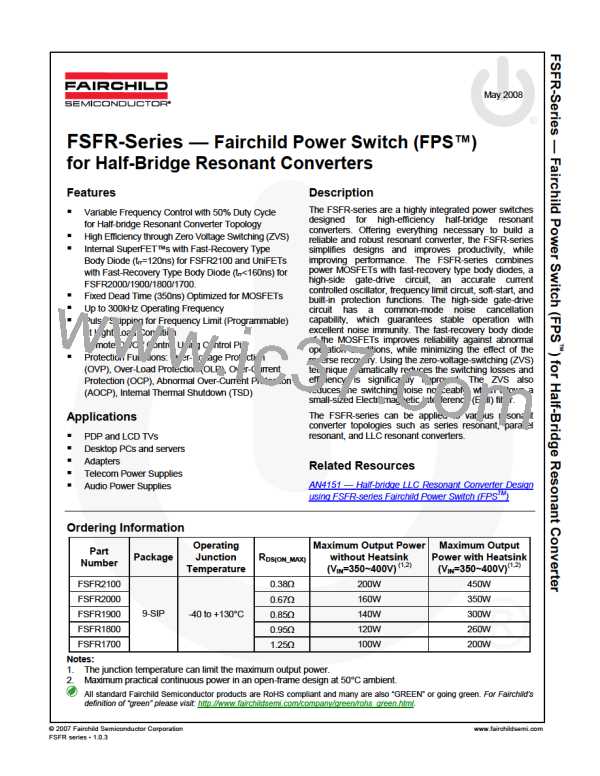Latch-Mode Protection: Once this protection is
triggered, switching is terminated and the MOSFETs
remain off. The latch is reset only when LVCC is
discharged below 5V.
Current Sensing Using Resonant Capacitor Voltage:
For high-power applications, current sensing using a
resistor may not be available due to the severe power
dissipation in the resistor. In that case, indirect current
sensing using the resonant capacitor voltage can be a
good alternative because the amplitude of the resonant
capacitor voltage (Vcrp-p) is proportional to the resonant
current in the primary side (Ipp-p) as:
p− p
Ip
p− p
(6)
VCr
=
2π fsCr
To minimize power dissipation, a capacitive voltage
divider is generally used for capacitor voltage sensing,
as shown in Figure 27.
Figure 24. Protection Blocks
Np
CON
Control
IC
Current Sensing Using Resistor: FSFR-series senses
drain current as a negative voltage, as shown in Figure
25 and Figure 26. Half-wave sensing allows low power
dissipation in the sensing resistor, while full-wave
sensing has less switching noise in the sensing signal.
Cd
Ns
Ip
Rd
PG
100
SG
Ns
Cr
VSENSE
CB
Cr
Np
Ns
Ns
CSENSE
Ip
Control
IC
VCS
Ids
CS
VCr
SG
PG
p-p
Rsense
VCr
VCS
Ids
pk
pk
Vsense
CB
Vsense
Vsense
=
p− p
=VCON
VCr
Csense + CB
2
pk
pk
Vsense
Figure 25. Half-wave Sensing
VCON
Ids
Vsense
Tdelay = Rd Cd
VCS
Figure 27. Current Sensing Using Resonant
Capacitor Voltage
5.1 Over-Current Protection (OCP): When the sensing
pin voltage drops below -0.6V, OCP is triggered and the
MOSFETs remain off. This protection has a shutdown
time delay of 1.5µs to prevent premature shutdown
during startup.
Cr
Control
IC
VCS
Np
Ns
Ns
CS
PG
SG
5.2 Abnormal Over-Current Protection (AOCP): If the
secondary rectifier diodes are shorted, large current with
extremely high di/dt can flow through the MOSFET
before OCP or OLP is triggered. AOCP is triggered
without shutdown delay when the sensing pin voltage
Rsense
Ids
Figure 26. Full-wave Sensing
© 2007 Fairchild Semiconductor Corporation
FSFR series • 1.0.3
www.fairchildsemi.com
12

 FAIRCHILD [ FAIRCHILD SEMICONDUCTOR ]
FAIRCHILD [ FAIRCHILD SEMICONDUCTOR ]